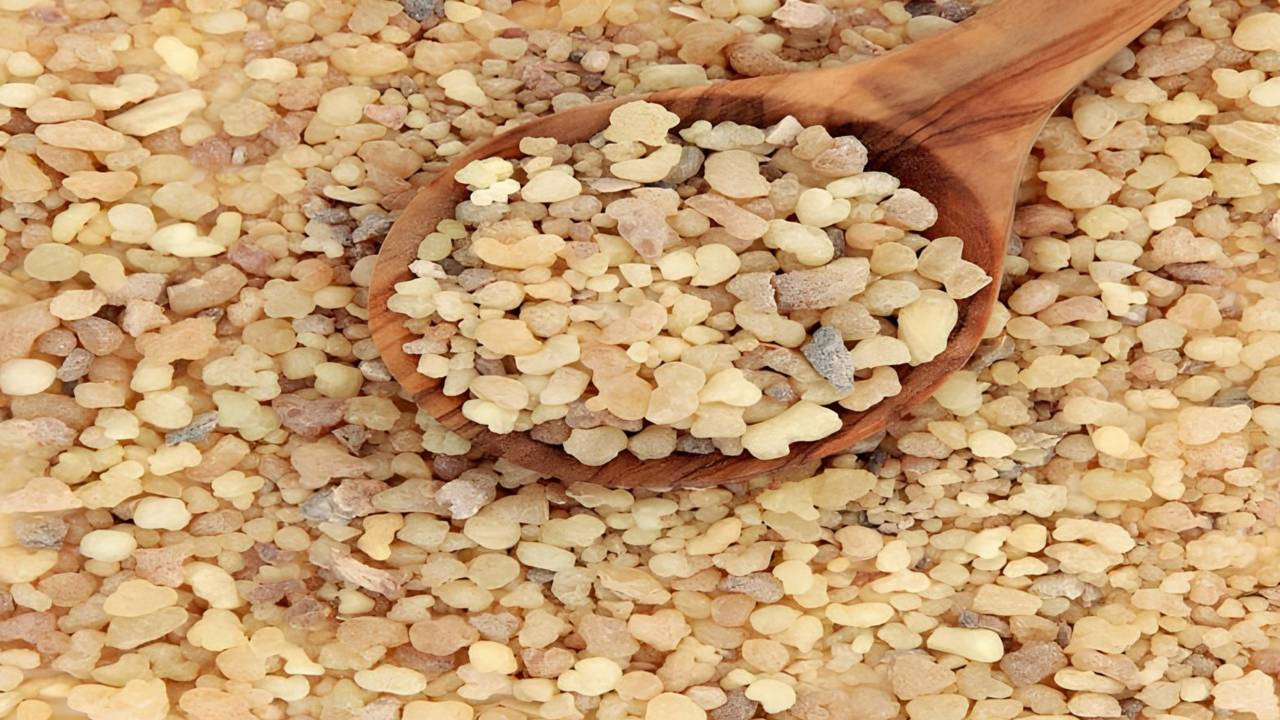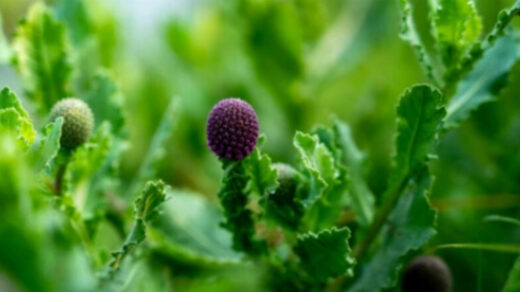Heeng (Asafoetida) Powder: The Spice of Health and Wellness
Ferula asafoetida Linn, commonly known as Hing or Heeng, is a perennial herbaceous plant and the most prominent among the 130 species of Ferula. The plant produces a distinctive oleo-gum-resin from its rhizome and root, which is collected in earthen pots and then dried.
This dried resin is widely used as a spice to enhance the flavor of various dishes and is available in both powder and crystal forms. In Hindi, it is called Hing or Heeng, while in English, it is known as Asafoetida. The term “Asafoetida” is derived from the Latin word “ferula,” meaning “vehicle” or “carrier,” and it is also sometimes referred to as “devil’s dung” or “stinking gum” due to its strong odor.
Beyond its culinary uses, Asafoetida offers several health benefits. It is renowned for its digestive properties, particularly in alleviating gas and bloating. Additionally, Asafoetida possesses antimicrobial and anti-inflammatory qualities, which contribute to its effectiveness in treating respiratory issues and supporting overall health.
What is Heeng?
Hing, or Heeng, is indeed the common name for Asafoetida, a spice that comes from the gum resin of the Ferula asafoetida plant.
Its strong, pungent aroma when raw is due to the high content of sulfur compounds, which can be quite overpowering. However, when cooked, it mellows into a more pleasant, savory flavor that resembles garlic and onions.
Here’s a quick breakdown of its key components:
- Resin (40–64%): This is the sticky, gum-like substance that gives Hing its unique characteristics.
- Endogenous Gum (about 25%): This contributes to the thick, sticky texture of the resin.
- Volatile Oil (10–17%): This oil is responsible for the pungent smell of raw Hing.
- Ash (1.5–10%): This includes minerals and other non-volatile components.
- Asaresinotannols ‘A’ and ‘B’: These are specific compounds that contribute to Hing’s distinctive properties.
- Ferulic Acid and Umbelliferone: These are naturally occurring compounds found in various plants, adding to the flavor profile and medicinal properties of Hing.
In cooking, Hing is often used in very small amounts because of its potent flavor. It’s commonly used in Indian and other South Asian cuisines, particularly in vegetarian dishes, to add depth and complexity.
It also has traditional medicinal uses, is believed to aid digestion, and has various health benefits.
Heeng Vernacular Names
It’s fascinating how Asafoetida, or Hing, is known by so many different names across various cultures and languages. Here’s a brief look at some of the vernacular names and what they reveal about the spice:
- Arabic: Zallouh, Anjadan, Hilteet, Simagh-ul-mehroos
- Assamese: Hin
- Bengali: Hing, Hingra
- English: Asafoetida
- Europeans: Devil’s dung (reflecting its strong, pungent aroma)
- Gujarati: Hing, Vagharni
- Marathi: Hing, Hira
- Hindi: Hingra, Hingu
- Oriya: Hengu, Hingu
- Kannada: Higu, Ingu, Hing
- Persian: Angoza, Nagoora, Amma, Nagsatgudha, Angzoo, Anksar
- Punjabi: Hing
- Sanskrit: Ramatta, Bhutnasan, Hingu, Sulansan, Bahleeka
- Suraini: Halteesa
- Telugu: Ingura, Inguva, Ing
- Turkish: şeytan boku (devil’s shit), Şeytantersi (devil’s sweat), şeytanotu (the devil’s herb)
- Urdu: Hilteet, Hing
The various names often reflect the spice’s unique properties or its strong flavor profile, sometimes with colorful or descriptive terms like “Devil’s dung” or “Devil’s sweat.”
In many languages, the names are quite similar, highlighting the widespread use and recognition of Hing across different cultures.
Heeng (Asafoetida) is Made From
Hing (Asafoetida) is made from the resin of the Ferula plant, specifically from certain species of this genus that are known to produce gum. Here’s a detailed overview of the process:
Plant Characteristics:
- The Ferula plant, from which Hing is derived, can grow to a significant size. By the time it reaches maturity (around five years), it has a thick crown (about 12 to 13 cm in diameter) and a flower stem that can be 10 cm thick and 2.5 to 3 meters tall.
Exudation Process:
- Timing: The process typically starts at the end of March, just before the plant begins to flower.
- Harvesting: The top of the root is laid bare, and the stem is cut near the crown to initiate the flow of resin.
- Collection: The resin exudes from the cut surface and initially forms a white gum-like substance. Over time, this resin hardens and is protected by a cover made from sticks and leaves.
Processing:
- Hardened Resin: After the resin hardens, it is scraped off and discarded. The process involves making additional cuts at intervals of about 10 days, allowing new resin to exude and be collected. This process can be repeated several times over a period of months.
- Final Product: The collected resin is then dried and processed into the form of Hing used in cooking.
Ferula Species and Asafoetida
- Variety of Species: There are over 130 species of Ferula globally, but only a few of these species produce the gum resin known as Asafoetida.
- Key Species: The specific species of Ferula that are used to produce Hing are particularly valued for their resin’s flavor and medicinal properties.
The resin’s pungent smell when raw is a result of its high sulfur content, but it mellows into a savory, garlic-like flavor when cooked. This unique property makes Hing a valuable ingredient in many cuisines, particularly in Indian cooking.
Heeng Synonyms
- Assam: Hin
- Sanskrit: Ramatha, Sahasravedhi
- Bengali: Hing
- English: Asafoetida
- Gujarati: Hing,
- Punjabi: Hing
- Vagharni Hindi: Hing, Hingda
- Oriya: Hengu, Hingu
- Kannada: Hingu, Ingu
- Marathi: Hing, Hira
- Kashmiri: Eng
- Malayalam: Kayam
- Telugu: Inguva
- Tamil: Perungayam
- Urdu: Hitleet, Hing
Heeng: Ayurvedic Perspective
In ancient Ayurvedic texts, Ferula assafoetida L is known as “Hingu.” This herb has been utilized both as a flavoring agent in food and as a remedy for various ailments for centuries, earning its place as a trusted traditional medicine.
Often referred to as the “food of the gods,” Asafoetida (Hing) has been integral to Indian medicine and cuisine since ancient times. Its unique properties make it a valuable addition to both culinary and therapeutic practices.
In Ayurvedic medicine, Asafoetida is prized for its ability to balance Vata and Kapha doshas. By alleviating imbalances in these doshas, Asafoetida is effective in addressing a range of health issues, including:
- Neurological Disorders: Helps in managing conditions such as paralysis, hysteria, depression, and epilepsy.
- Gastrointestinal Health: Assists in treating intestinal parasites, flatulence, weak digestion, and stomach pain.
- Respiratory Conditions: Useful in relieving symptoms of influenza and asthma.
- Reproductive Health: Beneficial for managing premature birth, painful and excessive menstruation, vaginal discharge, and infertility.
Asafoetida’s multifaceted benefits underscore its importance in Ayurvedic practices, reflecting its long-standing role in supporting overall health and well-being.
Ayurvedic Properties
Ayurveda, the traditional system of medicine from India, emphasizes a holistic approach to health and well-being. It is based on the balance of three doshas (bodily energies): Vata, Pitta, and Kapha. Each dosha is associated with specific qualities and elements, and Ayurvedic properties are used to balance these doshas and maintain health.
Doshas:
- Vata: Associated with the elements of air and space. It governs movement, creativity, and mental activity. Its qualities are dry, light, cool, rough, subtle, and mobile.
- Pitta: Associated with the elements of fire and water. It governs digestion, metabolism, and energy production. Its qualities are hot, sharp, light, oily, fluid, and spreading.
- Kapha: Associated with the elements of earth and water. It governs structure, stability, and lubrication. Its qualities are heavy, slow, steady, solid, cold, soft, and oily.
Gunas (Qualities):
- Sattva: Represents purity, harmony, and balance. It promotes clarity and understanding.
- Rajas: Represents activity, restlessness, and change. It drives action but can lead to agitation if excessive.
- Tamas: Represents inertia, darkness, and ignorance. It can lead to lethargy and confusion if not balanced.
Virya (Potency):
- Refers to the action or effect a substance has on the body. It can be heating (Ushna) or cooling (Shita).
Vipaka (Post-Digestive Effect):
- Refers to the effect a substance has after digestion. It can be sweet (Madhura), sour (Amla), or pungent (Katu).
Prabhava (Specific Effect):
- Refers to the unique effect a substance has, which may not fit into general categories.
Rasa (Taste):
- Sweet (Madhura): Nourishing and balancing.
- Sour (Amla): Stimulating digestion.
- Salty (Lavana): Enhances taste and digestion.
- Bitter (Tikta): Detoxifying and drying.
- Pungent (Katu): Stimulating and heating.
- Astringent (Kashaya): Drying and cooling.
These properties are used to guide dietary choices, herbal remedies, and lifestyle practices to maintain or restore balance among the doshas and promote overall health.
Ayurveda emphasizes personalized treatments, considering individual constitution (Prakriti) and current imbalances (Vikriti).
Uses of Heeng in Different Parts Of The World
Asafoetida, or Ferula assa-foetida, is indeed a fascinating and versatile substance used in various ways across different cultures. Here’s a quick summary of how it’s utilized around the world:
- Pakistan: Small bags of Asafoetida are worn around the neck or arm to guard against diseases.
- Afghanistan: The extract is consumed to treat whooping cough, ulcers, and hysteria.
- China: Asafoetida is used in decoction form as an anthelmintic (a treatment for worm infections).
- Egypt: The dried root extract is taken for its antispasmodic, diuretic, analgesic, and anthelmintic properties.
- Malaysia: Resin gum is chewed to address amenorrhea (absence of menstruation).
- Morocco: It’s employed as an anti-epileptic.
- Nepal: Water extract of the resin is used as an anthelmintic.
- Saudi Arabia: Dried gum treats bronchitis, whooping cough, and asthma.
- United States: Asafoetida’s fluid extract is taken as an emmenagogue, stimulating expectorant, aphrodisiac, anthelmintic, and a brain and nerve stimulant. It’s also known for its powerful antispasmodic effect.
- France: Asafoetida is used sparingly on hot plates, especially when preparing beef steaks.
- Europe: Asafoetida is valued as a medicinal substance and is also linked to various myths involving male deities and fertility. It’s thought to have origins related to divine semen according to local lore.
This plant’s diverse applications highlight its broad medicinal and culinary uses, reflecting a rich history of traditional practices.
Top 10 Benefits Of Heeng
Asafoetida, also known as Hing, is a spice with a strong aroma that is highly regarded in traditional medicine systems like Ayurveda. Here are some detailed benefits and applications of Asafoetida:
1. Skin Blemishes
Asafoetida is believed to have properties that can help improve skin appearance by addressing blemishes and dark spots. Its ability to control tyrosine production may help in reducing pigmentation and promoting a more even skin tone.
How to Use:
- Mix Asafoetida powder with hot water to form a paste.
- Apply this paste to areas affected by blemishes or dark spots.
- Leave it on for 10-15 minutes before rinsing off.
2. Natural Remedies for Inflammation and Pain
Asafoetida has anti-inflammatory and analgesic properties that can help alleviate various types of pain, including toothaches, headaches, and menstrual cramps.
How to Use:
- For Headaches/Migraines: Mix a pinch of Asafoetida powder with warm water and drink it.
- For Toothache: Make a thick paste with Asafoetida powder and lemon juice, and apply it directly to the affected tooth or gums.
3. Menstrual Pain & Irregular Periods
Asafoetida can be beneficial for managing menstrual pain and irregular periods due to its properties that support smooth blood flow and hormonal balance.
How to Use:
- Lightly roast Asafoetida powder in a pan.
- Mix the roasted powder with buttermilk and a bit of sugar.
- Consume this mixture during menstruation to help ease pain and regulate periods.
4. Natural Remedy for Stomach Gases
Asafoetida aids in digestion and can help reduce bloating and gas. Its inclusion in daily cooking can be a preventive measure against gas issues.
How to Use:
- Add a pinch of Asafoetida to your dishes while cooking.
- For immediate relief, mix a pinch of Asafoetida powder in a glass of warm water and drink it. Optionally, add a pinch of black salt for added benefits.
5. Natural Remedy for Baby Gas Relief
Asafoetida is also used to provide relief from gas and colic in babies, though caution is advised when using it internally.
How to Use:
- External Use: Create a paste of Asafoetida powder and water. Apply this paste to the baby’s navel area to help relieve gas.
- Internal Use: Crush a small amount of Asafoetida crystal (about the size of two mustard seeds) and dissolve it in warm water. This can be given to the baby in very small quantities, but it’s important to consult with a pediatrician before using this method.
6. Improves Respiratory Health
Asafoetida has expectorant properties that can help alleviate respiratory issues such as asthma, bronchitis, and coughs by promoting mucus expulsion and soothing the respiratory tract.
How to Use: Mix a pinch of Asafoetida powder with honey and consume it to ease respiratory discomfort.
7. Enhances Digestion
Asafoetida aids in improving digestive functions by reducing bloating, gas, and indigestion. It stimulates digestive enzymes and promotes overall gut health.
How to Use: Incorporate Asafoetida into your cooking, or take a pinch mixed with warm water after meals.
8. Supports Immune Function
The spice has antioxidant and anti-inflammatory properties that boost the immune system, helping the body fight off infections and illnesses.
How to Use: Regularly include Asafoetida in your diet or take it as a supplement to support immune health.
9. Reduces Symptoms of Depression and Anxiety
Asafoetida has mood-enhancing properties and may help alleviate symptoms of depression and anxiety by balancing brain chemistry and reducing stress.
How to Use: Use Asafoetida in your cooking or consume it with honey to potentially uplift mood and reduce anxiety.
10. Regulates Blood Sugar Levels
Asafoetida can help manage blood sugar levels by improving insulin sensitivity and reducing glucose spikes, which is beneficial for individuals with diabetes or prediabetes.
How to Use: Incorporate Asafoetida into your daily meals, or consult a healthcare provider for appropriate dosage and use as a supplement.
How To Check Quality Of Heeng?
Checking the quality of asafoetida (hing) is important to ensure you’re getting a pure and effective product. Here are some detailed methods to test the quality of asafoetida:
1. Dissolution Test:
Purpose: To determine if the asafoetida is pure or adulterated. How to Use:
- Procedure: Take a small piece of asafoetida resin or powder and drop it into a glass of water.
- Observation: Pure asafoetida should gradually dissolve in water, turning the water into a milky white solution. If it is adulterated or impure, it may not dissolve completely and could settle at the bottom or cause the water to remain cloudy without turning milky.
- Explanation: Pure asafoetida is soluble in water due to its resins and essential oils. Adulterants or fillers often do not dissolve well, indicating the presence of impurities.
2. Burn Test:
Purpose: To check for purity and absence of artificial additives.
How to Use:
- Procedure: Light a small piece of asafoetida on a flame.
- Observation: Pure asafoetida should burn cleanly with little to no residue. The smell should be strong and characteristic, with no artificial or chemical odor.
- Explanation: Pure asafoetida, when burned, should not leave a residue because it is a natural resin. If it leaves behind residue or has an unusual smell, it could be mixed with other substances or adulterants.
3. Smell Test:
Purpose: To assess the freshness and authenticity of the asafoetida.
How to Use:
- Procedure: Smell the asafoetida directly.
- Observation: Pure asafoetida has a strong, pungent odor. The smell is often described as earthy, sulfurous, or similar to garlic. If the odor is weak or off, it may be a sign of poor quality or adulteration.
- Explanation: The distinctive pungent smell is due to its natural volatile oils. A lack of strong aroma can indicate that the asafoetida is old, diluted, or mixed with other substances.
4. Texture and Color Check:
Purpose: To verify the physical characteristics of the asafoetida.
How to Use:
- Procedure: Examine the asafoetida resin or powder visually and by touch.
- Observation: Pure asafoetida is usually a sticky, amber-colored resin or powder with a smooth texture. If it appears excessively dry, dusty, or has an unusual color, it may be a sign of poor quality or adulteration.
- Explanation: The natural resin of asafoetida should be somewhat sticky and have a characteristic color. Any deviation in texture or color might indicate that the product is old, diluted, or mixed with fillers.
5. Solubility Test in Oil:
Purpose: To check if the asafoetida contains fillers or non-dissolving components.
How to Use:
- Procedure: Mix a small amount of asafoetida in warm oil (such as vegetable oil).
- Observation: Pure asafoetida should dissolve or disperse well in oil, giving it a slightly cloudy appearance. If it clumps together or does not mix well, it might be adulterated.
- Explanation: Asafoetida’s essential oils and resins are soluble in oil. Fillers or adulterants may not dissolve well, affecting the quality of the product.
6. Check for Manufacturer Information:
Purpose: To ensure that the product is from a reputable source.
How to Use:
- Procedure: Look for packaging that includes the manufacturer’s name, address, and expiration date.
- Observation: Ensure the product has clear labeling and is from a trusted brand or supplier.
- Explanation: Reputable manufacturers are more likely to provide high-quality, pure products. Proper labeling also indicates compliance with quality standards.
By using these methods, you can better assess the quality of asafoetida and ensure you are purchasing a pure and effective product.
Asafoetida (Heeng) Side Effects
According to WebMD : Asafoetida is considered to be safe for most people in the amounts which are typically found in food. Some evidence also showed that Asafoetida is possibly safe when taken orally as medicine.
Few people have stated problems with Asafoetida which causes belching, intestinal gas, diarrhea, swelling of the lips, seizures, blood disorders, headache, and other side effects.
- Children: Asafoetida is unsafe for infants when taken orally because it could cause certain blood disorders.
- Pregnancy: It is unsafe to take Asafoetida orally if you are pregnant as it could cause a miscarriage so avoid use.
- Breastfeeding: It is also considered unsafe if consumed orally while breastfeeding because some chemicals in Asafoetida could pass into breast milk and cause bleeding disorders in infants so avoid it.
As people worldwide increasingly choose organic and health-conscious lifestyles, incorporating Asafoetida spice offers a flavorful and effective alternative to modern medicine. With its rapid therapeutic benefits and lack of side effects, regular use of Asafoetida can help maintain health and vitality for years to come.



























Kaunda Need sir